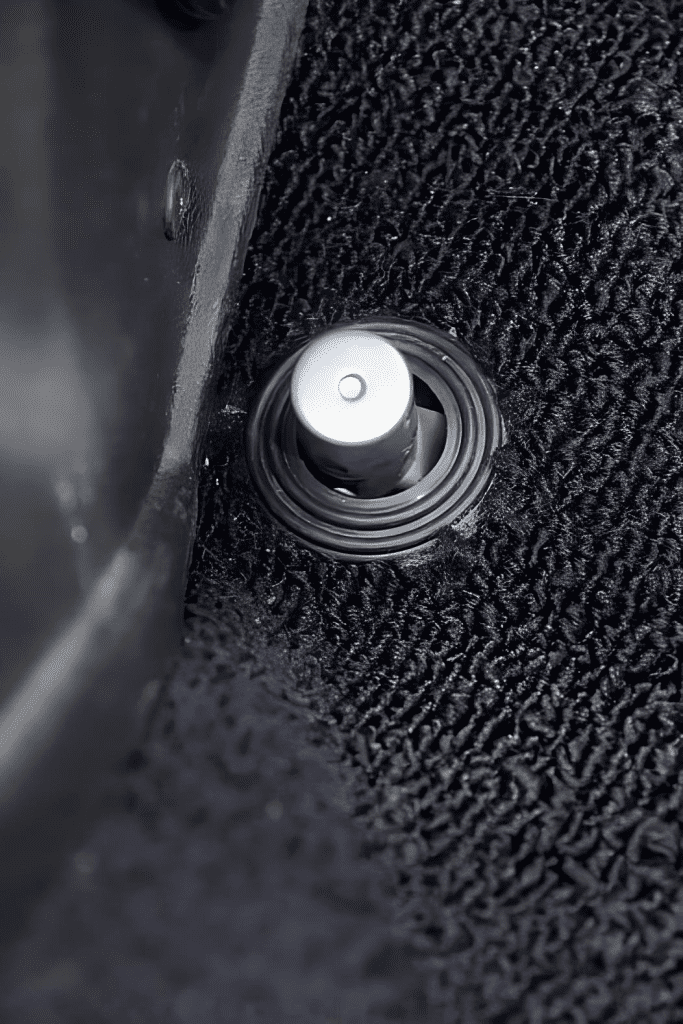In an age of complex car technology, modern drivers might be surprised to learn about an old feature that was once common in vehicles—the high beam headlight dimmer switch on the floor. Many younger museum visitors are intrigued when they spot the small button on the floorboard to the left of the pedals, wondering about its purpose. This curious button, widely used throughout the mid-20th century, was the original dimmer switch, designed to toggle between high and low beam headlights. Understanding its history sheds light on the shifting trends in automotive design and driver convenience.
The Invention of the High Beam Headlight Dimmer Switch

In 1925, automotive lighting took a leap forward with the Guide Lamp Co.’s introduction of the two-filament headlight bulb. This innovation allowed drivers to switch between low and high beams as needed, an important safety feature for navigating poorly lit roads. Originally, the dimmer switch was mounted on the steering column, which allowed drivers to control the beams with minimal effort. However, by 1927, concerns arose about drivers needing to take one hand off the wheel to activate the switch, leading manufacturers to move it to the floor where it stayed for nearly 50 years.
The Golden Era of the Floor-Mounted Dimmer Switch
From the late 1920s through the 1970s, the floor-mounted dimmer switch reigned supreme. Located conveniently on the floor near the driver’s left foot, this button allowed drivers to toggle between low and high beams with a simple press. It provided a hands-free solution that didn’t interfere with steering, especially useful for long-distance night driving. The switch became an essential feature, and generations of drivers became accustomed to the satisfying click of the floor-mounted button. However, this placement wasn’t without its drawbacks, which would later lead to a major change in its location.
Challenges of the Floor-Mounted Switch for Manual Transmission Vehicles
One key downside of the floor-mounted dimmer switch became apparent for drivers of manual transmission vehicles. In cars with manual transmissions, the driver’s left foot is responsible for operating the clutch pedal, which left it “unavailable” to press the dimmer switch button if needed. Shifting gears while trying to toggle the high beams created a balancing act for drivers and highlighted the limitations of the floor-mounted dimmer in manual vehicles. This challenge, coupled with the shift towards smaller, fuel-efficient foreign cars, would eventually prompt a redesign.
The Shift Back to Steering Column-Mounted Dimmer Switches
By the 1970s, global automotive trends began influencing American cars. The energy crisis had spurred a demand for smaller, fuel-efficient vehicles, and many drivers turned to European imports, which typically featured a stalk-mounted dimmer switch on the steering column. This design allowed drivers to operate headlights, turn signals, and other functions without removing their hands from the wheel. The popularity of European cars, coupled with the convenience of the steering column-mounted switch, quickly caught on with American drivers.
However, switching from a simple floor-mounted button to a multi-functional stalk switch required a more complex design and often had to wait until a full vehicle redesign. This delay meant that some American vehicles continued to use the floor-mounted dimmer switch into the early 1990s, particularly on trucks where space and traditional designs were still prioritized.
The Rise of the Multi-Function Stalk Switch
As the steering column-mounted dimmer switch grew in popularity, manufacturers saw an opportunity to incorporate other functions onto the stalk, making it a convenient all-in-one control for drivers. The dimmer switch shared space with the turn signals, wiper/washer controls, and eventually cruise control functions. By consolidating these controls into a single stalk, drivers gained a streamlined experience, but it also introduced a learning curve. Drivers now had to familiarize themselves with multiple functions within a compact space on the steering wheel, leading to some confusion, especially in the early years of this design.
Safety and Convenience: Why the Floor-Mounted Dimmer Faded Away

The switch to a steering column-mounted dimmer was driven by both safety and convenience concerns. For one, the steering column switch reduced the time drivers spent taking their hands off the wheel, which improved reaction times and ultimately enhanced road safety. It also resolved the issues manual transmission drivers faced with the floor-mounted switch, offering a consistent, hands-free solution. While some purists may argue that the floor-mounted dimmer switch was simpler and more reliable, the shift to the column-mounted switch marked a move towards a more standardized and driver-friendly design.
Automatic Headlight Dimming: The Modern Solution
Today, most cars offer automatic headlight dimming, using sensors to detect oncoming vehicles and adjusting the beams accordingly. This feature reduces the need for manual toggling between low and high beams, enhancing safety by reducing glare for oncoming drivers. With automatic dimming, the debate over the ideal switch location has largely become a thing of the past. However, for vintage car enthusiasts, the floor-mounted dimmer switch remains a nostalgic feature that brings back memories of classic car designs and simpler times.
Conclusion: The Legacy of the High Beam Dimmer Switch
The journey of the high beam dimmer switch from the steering column to the floor and back again reflects the evolving priorities of car design—balancing safety, convenience, and driver preferences. While automatic headlights have largely replaced the need for a manual dimmer switch, the legacy of the floor-mounted button endures as a unique chapter in automotive history. For those who have driven with both types, the memory of the floor-mounted dimmer switch is likely a cherished piece of driving nostalgia, a reminder of the innovations that have shaped the cars we drive today.


